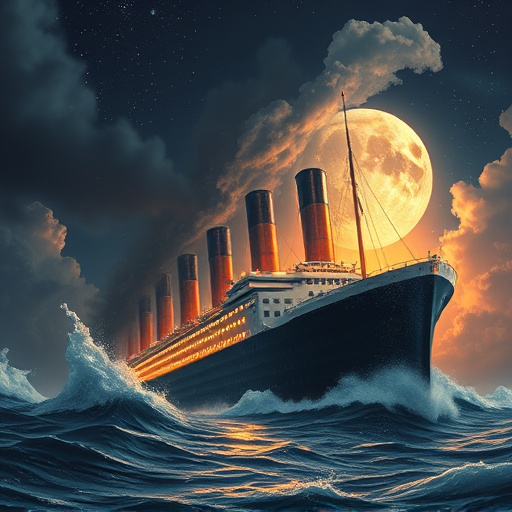“The Titanic, a name that resonates with grandeur and tragedy, continues to captivate the world over a century later. This iconic ship, considered unsinkable, met its fate on its maiden voyage in 1912. From the luxurious cabins to the bustling dance floors, delve into the historical context leading up to this maritime disaster. Explore how the Titanic‘s tragic end left an indelible mark on popular culture and its enduring legacy. Unravel the story that has inspired countless films, books, and art.”
The Historical Context and Build-up to the Titanic's Voyage
The Titanic, a marvel of engineering and luxury, set sail on its ill-fated maiden voyage in April 1912. Its construction was a testament to human ingenuity and industrial might, with the ship representing the pinnacle of maritime technology at the time. Built by the Harland and Wolff shipyard in Belfast, Ireland, the Titanic was designed as an ocean liner that promised unparalleled comfort and speed across the Atlantic. The build-up to its launch was marked by excitement and media buzz, as folks around the world eagerly awaited what was touted as an unsinkable vessel.
The historical context of the time was one of rapid globalization and expanding trade routes. With the rise of mass migration, the need for larger and faster ships grew, driving competition among shipping lines to create the most opulent and advanced vessels. The Titanic’s voyage was part of this competitive landscape, where safety measures were a secondary consideration to speed and luxury. This context, coupled with the ship’s grand promises, set the stage for the tragic events that unfolded on its fateful journey.
The Disaster: A Night to Remember
On a fateful night in April 1912, the Titanic, often hailed as the “unsinkable ship,” met its match in the frigid waters of the North Atlantic. What began as an ambitious voyage to showcase maritime engineering and luxury quickly turned into a nightmare as the vessel collided with an iceberg. This disaster, which claimed over 1500 lives, remains one of history’s most infamous maritime tragedies.
The night unfolded with a sense of calm that belied the impending doom. Despite warnings about icebergs in the area, the ship maintained its speed. As the clock struck 11:40 PM, a collision with an iceberg shattered the Titanic‘s hull, opening multiple compartments to the ocean’s wrath. Within minutes, the once-proud vessel began to sink, taking with it dreams, hopes, and lives from all walks of life, from wealthy aristocrats to ordinary passengers seeking a better future.
Legacy and Impact: The Titanic's Enduring Story in Popular Culture
The Titanic has left an indelible mark on popular culture, its story reverberating through various forms of media for over a century. From movies and books to documentaries and museums, the ship’s legacy continues to captivate audiences worldwide. This enduring fascination can be attributed to the tragedy’s sheer magnitude and the myriad of personal stories it encompasses. The Titanic‘s tale serves as a reminder of a bygone era, offering insights into 20th-century society and the complexities of human nature.
Its impact is evident in numerous titanic-themed productions that have dominated the entertainment industry. From James Cameron’s epic film to various stage musicals, these creative interpretations have not only entertained but also educated generations about one of history’s most infamous maritime disasters. The ship’s iconic image and the haunting tale of love and loss amidst the tragedy have solidified its place as a cultural phenomenon, ensuring that the Titanic‘s story remains relevant and inspiring for years to come.
